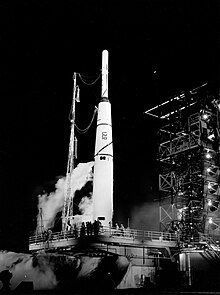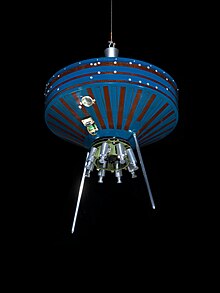Pioneer 1
 | |
| Mission type | Lunar orbiter |
|---|---|
| Operator | NASA |
| Harvard designation | 1958 Eta 1[1] |
| COSPAR ID | 1958-007A |
| SATCAT no. | 110[1] |
| Mission duration | 2 days (43 hours)[2] |
| Apogee | 113,800 kilometers (70,700 mi) |
| Spacecraft properties | |
| Manufacturer | Space Technology Laboratories |
| Launch mass | 34.2 kilograms (75 lb)[1][3] |
| Start of mission | |
| Launch date | 11 October 1958, 08:42:00 GMT LC-17A |
| End of mission | |
| Decay date | 13 October 1958, 03:46 GMT |
Pioneer 1 (also known as Able 2)
Spacecraft design

Pioneer 1 was fabricated by Space Technology Laboratories, a division of Ramo-Wooldridge Corp (later TRW Inc.),[6] and consisted of a thin cylindrical midsection with a squat truncated cone on each side. The cylinder was 74 cm (29 in) in diameter and the height from the top of one cone to the top of the opposite cone was 76 cm (30 in). Along the axis of the spacecraft and protruding from the end of the lower cone was an 11 kg (24 lb) solid propellant injection rocket and rocket case, which formed the main structural member of the spacecraft. Eight small low-thrust solid propellant velocity adjustment rockets were mounted on the end of the upper cone in a ring assembly which could be jettisoned after use. A magnetic dipole antenna also protruded from the top of the upper cone. The shell was composed of laminated plastic. The total mass of the spacecraft after vernier separation was 34.2 kg (75 lb), after injection rocket firing it would have been 23.2 kg (51 lb).
The three-stage Thor-Able vehicle consisted of a modified Air Force Thor IRBM (liquid propellant, thrust about 69,400 kg (153,000 lb)) as the first stage. A liquid-propellant rocket engine powered the second stage (modified Vanguard second stage, thrust about 3,402 kg (7,500 lb)). The third stage was a solid-propellant unit based on Vanguard design, rated at 116,500 lb (52,844 kg)-sec total impulse.[7]
The scientific instrument package had a mass of 17.8 kg (39 lb) and consisted of an image scanning infrared television system to study the
Mission
This section needs additional citations for verification. (April 2024) |

Two days after the failure of Pioneer 0 on 17 August 1958, Thor 129, the backup vehicle, was erected on LC-17B in preparation for a September attempt. The postflight investigation of Pioneer 0 pointed to a turbopump failure, which had also caused the loss of Thor-Able 116 in April.[citation needed] This was followed by the failure of an Atlas launch on 18 September, so the Air Force moved to replace the turbopumps in their inventory of Thor and Atlas missiles.[citation needed] Thor 129 was pulled from the pad for modifications and replaced with Thor 130.
On 11 October 1958, Pioneer 1 lifted off smoothly, but the guidance system steered the Thor slightly too high and fast, causing the second stage to be lofted 3° higher than intended. As a result, it shut off 10 seconds earlier than planned, and also bumped the third stage during separation. The third stage was left pitched up about 15° and suffering a velocity shortfall of about 500 feet per second. The vernier engines on the third stage were fired to make up for the thrust deficit, but added only 150 feet per second of velocity, insufficient to escape Earth orbit. As a last resort, ground controllers decided that if they could not get Pioneer 1 to the Moon, they would place it in a high Earth orbit by firing the attached solid rocket motor. The inaccurate launch trajectory, however, had placed the probe on an orbital track that resulted in thermal heating and cooling beyond what the primitive temperature control system could handle. The probe's internals fell to near-freezing temperatures, rendering the solid motor igniter inoperable. Pioneer 1 reached a total distance of 113,800 km (70,712 mi) before beginning its descent back to Earth.[8]
The spacecraft was launched from
See also
References
- ^ a b c "NASA - NSSDCA - Spacecraft - Details".
- ^ a b "NASA - NSSDCA - Spacecraft - Telemetry Details". nssdc.gsfc.nasa.gov. Retrieved 18 August 2023.
- ^ 1958 NASA/USAF Space Probe (ABLE-1) Final Report: Volume 2. Payload and Experiments (Report). Space Technology Laboratories. February 18, 1959. Archived from the original on April 12, 2022. Retrieved February 17, 2009.
- ^ "In Depth | Pioneer 1". NASA. Retrieved 20 Feb 2021.
- ^ "Pioneer 1 - NSSDC ID: 1958-007A". NASA NSSDC.
- ^ "Pioneering Space”
- hdl:2060/19940003358. Retrieved 24 September 2011.
- ^ "Moon Rocket Falls, Burns Up; Plunges Back Into Atmosphere". Pittsburgh Post-Gazette. Associated Press. October 13, 1958. p. 1. Retrieved March 7, 2011.
External links
- United States Space Program Progress 1958 discusses Pioneer 0 - 3 at YouTube
- Space Technology Laboratories Documents Archive
- Historic Spacecraft Richard Kruse

